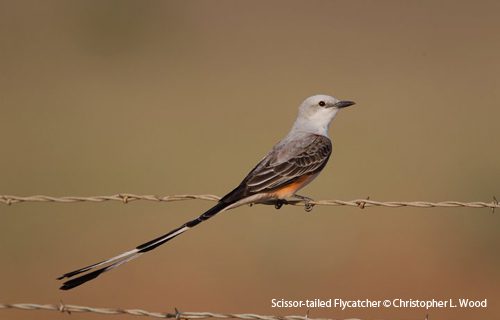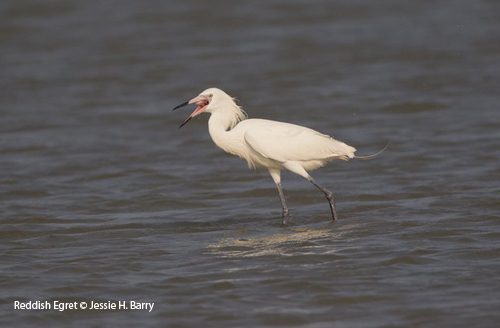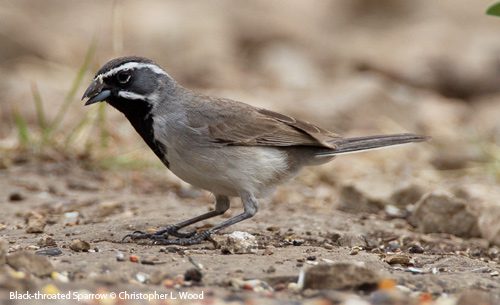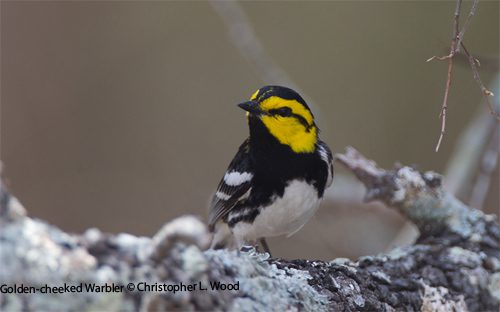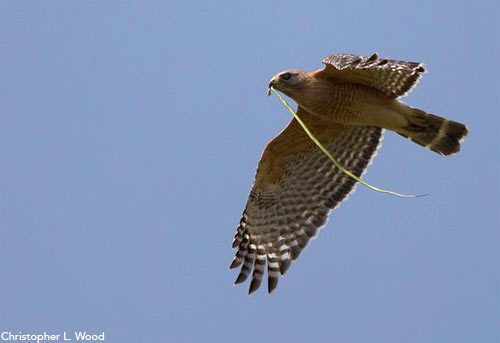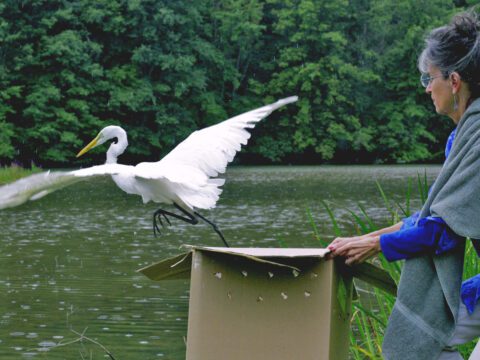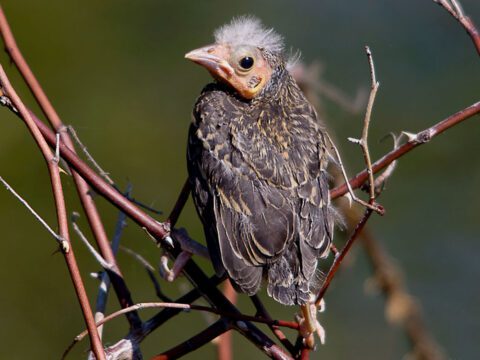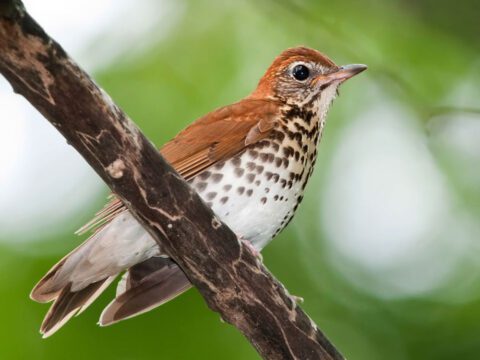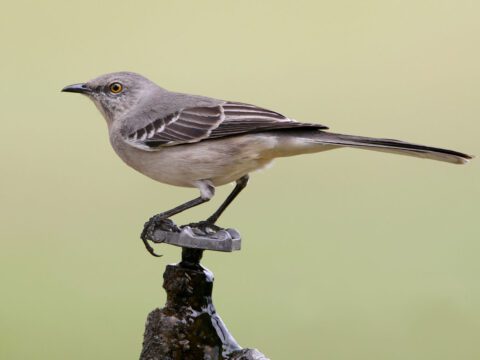Big Day scouting report: Heating up in Texas
By Hugh Powell April 20, 2011
One of the best things about scouting in Texas: all the Scissor-tailed Flycatchers 
Chris and Jessie spotted a white-phase Reddish Egret near Port Aransas 
Western species like Black-throated Sparrow barely come within the team's reach in the Hill Country 
Endangered Golden-cheeked Warblers have been a spectacular sight during scout week. 
This Red-shouldered Hawk was heading for its perch and a breakfast of snake.
At the Cornell Lab yesterday we had snow, hail, freezing rain, and regular rain. In Texas, where our Big Day team is scouting for an attempt at the North American record on Friday (and raising money for conservation), it was 88 degrees with a hot 30-mph wind blowing out of the south. Over the phone, I could barely hear Marshall Iliff because of a Summer Tanager over his head, belting out its song.
As envious as I was about the warm temperatures and 20+ species of warbler the team has seen so far, the weather may be more of an adversary than an ally on the Big Day. With the heat and the wind, “In terms of migration fallout, it looks like it’s not going to be the big pileup of migrants on the Texas coast that you sometimes see,” Brian Sullivan told me. “So we’re trying to find as many lingering wintering birds and breeding birds as we can, to link as many of those together as we can to get to our total.”
That’s not to say that the team’s list is anything like sparse. As Brian spoke to me, he and Andrew Farnsworth were scanning a flooded ricefield. “We’re looking at stacks of Pectoral Sandpipers, Stilt Sandpipers, Lesser Yellowlegs, phalaropes,” Brian said. “Out in the middle there’s a heronry with nesting Cattle Egrets and Roseate Spoonbills.” Andrew interrupted to point out a White-rumped Sandpiper. Farther along their route, which they’ll visit during the early afternoon on the Big Day, they’ll pick up “grasspipers”: Buff-breasted, Upland, Baird’s Sandpipers, Long-billed Curlew, possibly Hudsonian Godwit. They’ll also swing just northeast enough to find some classic eastern forest species: Blue Jay, Downy Woodpecker, American Crow, Red-bellied Woodpecker.
With a goal of seeing 262 species in 24 hours, the name of the game is habitat diversity. That’s why Texas is the place to make and break Big Day records: within a roughly 150-mile radius, birds from four parts of the continent come within driving range: eastern forest birds jut up against western desert species; Gulf Coast seabirds approach Hill Country endemics; and birds from the tropics—migrants on their way “home” as well as tropical residents at their northern range limit—fill in from the south.
Marshall and teammate Tim Lenz were in the Texas Hill Country, racking up species with a decidedly western feel: Scaled Quail, Cactus Wren, Audubon’s Oriole, Lark Bunting. “I think Bushtit is the only common bird we haven’t been able to find so far,” Marshall said. Then it’ll be a matter of optimizing the route—deciding where to spend each minute of the day. Even this aspect of a Big Day requires incredible bird knowledge. “We need to arrange it so we’re there when the birds are waking up,” so the team can save daylight minutes they’ll need later, Marshall said. “It’s important to know what time we can get Great Kiskadee, how early does Green Kingfisher start calling, what time do the Wood Ducks fly overhead?”
Chris Wood and Jessie Barry will lead the late afternoon stretch through the Corpus Christi and Port Aransas areas. On the beaches and barrier islands they’ll be hoping for as many migrants as the weather brings them. “There’s not much we can really do to scout that,” Jessie said, “but we’re making sure we get all the lingering ducks and shorebirds we can, like Whimbrel, Long-billed Curlew, Lesser and Greater Scaup, Fulvous Whistling-Duck, Northern Pintail.” They’ve found a reliable Tropical Kingbird they can pick up as late as 10 p.m.—then it’ll be back out to the marshes to spend their remaining hours finding Yellow, Black, and King Rails.
Holding on to migrants that are on the verge of departing is one major source of anxiety. “There’s a Say’s Phoebe that sits on one fence every time Tim and I drive past,” Marshall said. “We know it’s going to migrate sometime in the next week, and we just hope it’s not before we do the route.” Brian and Andrew are hoping the same thing for a single Snow Goose they ran across unexpectedly yesterday. A Northern Pintail and a Ring-necked Duck that Jessie had been hoping would stick around are among the birds that have already left—forcing the scouters to fan out looking for replacements.
When Friday arrives—or Thursday night, since the Big Day starts at midnight—the team will be eager to start counting Texas birds in earnest. With luck, the weather will serve up a few unexpected migrants, the Easter weekend traffic will be merciful, and a Common Pauraque will flash across their headlights on some dirt road, just before midnight. Follow their progress with us on Facebook.
Team Sapsucker thanks their scouting compadres: Ken Rosenberg, Nate Senner, and Lewis Grove from the Cornell Lab; and Texas locals Mel Cooksey, Willie Sekula, and Derek Muschalek; as well as the many landowners who have kindly granted them permission to bird on their land.

All About Birds
is a free resource
Available for everyone,
funded by donors like you
American Kestrel by Blair Dudeck / Macaulay Library
